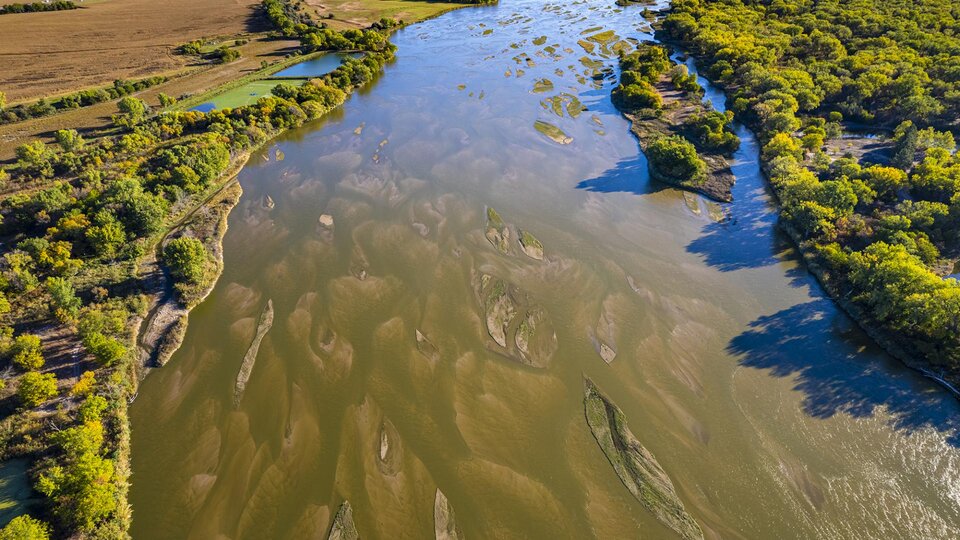Vision for an Ecologically Sound Platte River Basin (VESPR)
Across Wyoming, Colorado and Nebraska, the Platte River system is vital for drinking water, irrigation, wildlife, ecotourism, recreation and various other municipal and industrial uses. The current water management systems for the Platte Basin, including governing regulations and policies, are not guaranteed or designed to explicitly enhance long-term ecosystem resilience.
Many agricultural activities, conservation efforts and other programs within the Platte River Basin are dependent on the regulatory requirements associated with these systems and are typically implemented retroactively. These are largely designed to address the sustainability of a limited number of outputs (e.g., endangered species and irrigation-based agriculture) rather than holistic ecosystem management.
To prepare for the future uncertainty of water availability (in terms of both amount and timing), management of the Platte River Basin needs to move toward proactive measures that go beyond the limits of what can and cannot be done within current regulatory frameworks.
Outcomes of VESPR
The outcomes of VESPR are to develop and implement a long-term vision for the Platte River that:
- Takes a collaborative, ecosystem-based approach to water management
- Focuses on a diversity of wildlife needs and ecosystem function
- Recognizes the importance of balancing the needs of wildlife, irrigation, ecotourism, human consumption and municipal and industrial uses
- Focuses on building social and ecological resilience in the Platte River Valley and major tributaries
Platte River management should meet the needs of multiple water users, ensure ecological integrity and function, support the natural hydrograph with higher flows as well as base flows and value wet meadows and lowland prairies as critical for land conservation.
Operationalizing Resilience: VESPR
A diversified management approach centered around ecosystem function and resilience is best suited to meet the future needs of the Platte River Basin. This also includes building resilience in the social systems associated with the river; however, people’s perceptions, concerns and desired future conditions are largely unknown.
Public support and buy-in are critical to achieve the scale of management needed to safeguard all benefits the Platte River Basin provides various user groups (e.g., agricultural, recreation and municipal interests). Stakeholders and communities within all three Platte Basin states should equitably develop and embrace a long-term vision with solutions for the entire Platte River ecosystem.
The Vision for an Ecologically Sound Platte River Basin (VESPR) was formed to build a dynamic governance structure in which trust, collaboration and shared outcomes drive natural resources management in the Platte River Basin using science-based decisions. This effort is unique in scale and scope and will work in parallel with other conservation efforts within the Platte River Valley and its major tributaries.
Goals of VESPR
- Implement a long-term plan to address a diverse set of future scenarios and needs
- Maintain ecological functionality in the lower Platte River
- Restore the central Platte River
- Protect and enhance ecological function in the North and South Platte Rivers
- Protect, restore, and enhance lowland tallgrass prairie
- Direct management and conservation efforts to benefit waterbirds, grassland birds, endemic aquatic communities, terrestrial communities, and pollinators
- Engage stakeholders
- Understand and incorporate public perceptions, needs, and desired future conditions
- Make science-based decisions
- Garner public and political support
- Educate citizens regarding mutual benefits of conservation efforts for both wildlife and humans
What We’re Learning: A Polycentric Approach
VESPR participants share common priorities centered around ecosystem conservation, protection, restoration and resilience. They use the best available science in carrying out such efforts. Participation in this multiple stakeholder effort is informal but allows representatives to prioritize their contributions based on their individual or agency strengths, resources and directives.
The scale of challenges facing the Platte River’s communities and wildlife requires an interdisciplinary approach (i.e., polycentricity). A long-term solution will involve policy, education, science, a unified voice, collaboration, advocates, a diverse set of stakeholders and a durable public will. Scientific advances and the need for accomplishing this vision will need to be articulated to decision-makers and regulators. For policy to effectively balance multiple needs, it must evolve, pursue innovative solutions and be informed by a wide coalition of interests.
Over the next 50 years, management must improve water quality, take an ecosystem approach across multiple states, prepare for and adjust to changing conditions across the entire Platte River Basin and take extreme weather events of a changing climate into management considerations. Anything short of this approach is unlikely to maintain the Platte River Basin in a state that provides a diverse array of benefits to people and wildlife.
About VESPR
Representatives from the Crane Trust, Ducks Unlimited, National Audubon Society, Nebraska Game and Parks Commission, The Nature Conservancy, Playa Lakes Joint Venture, U.S. Fish and Wildlife Service, University of Nebraska at Lincoln and Prairie Plains Resource Institute are currently involved in VESPR. Other institutions, organizations, agencies and stakeholders in Nebraska, Colorado and Wyoming will also need to be involved to achieve the vision. Contact crawl@unl.edu for more information.

